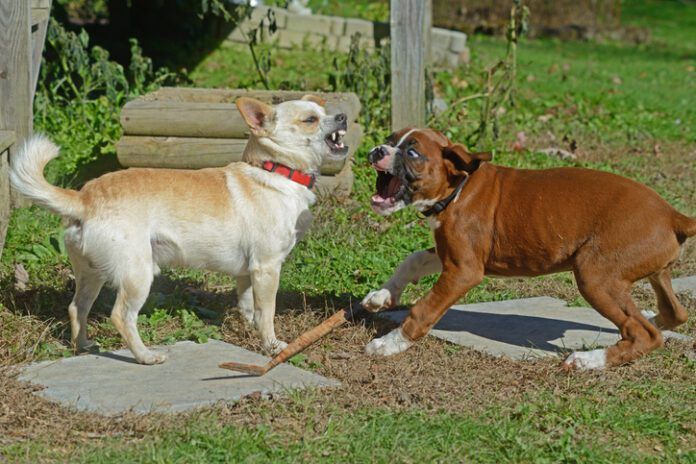
It might come as a shock when your sweet fluff of a baby dog suddenly and fiercely stakes a claim to the treats that you’ve been tossing to your adult dogs. Your dogs have always shared quite nicely with each other, and until recently, the puppy has, too. So why is he suddenly resource-guarding from his dog friends? And what can you do about it?
First, don’t panic. Resource-guarding is a natural, normal canine behavior. Sometimes referred to as “possession aggression,” resource-guarding is when a dog sends body-language signals to another dog (or human) that he is not willing to share whatever valuable item (food, treats, toy) he possesses or desires possession of.
Ideally, the guarding dog sends only low-level signals to his competitor, such as a hard stare, a freeze, hovering over the desired object, a growl, or a snarl. These appropriate, social-communication signals are intended to prevent conflict by deterring the competitor from approaching – and this often works! If, however, the target of this communication ignores the signals and continues to approach – or offers offensive social signals in return – the guarder may feel forced to escalate the intensity of his signals and may snap, lunge, or engage in actual aggressive contact (a fight).
Or, unfortunately, sometimes a guarder may launch at his perceived competitor without giving any warning, which deprives the “offending party” of the opportunity to move away. This can happen for several reasons:
- The resource guarding dog has had prior conflicts that have increased his stress level about resources to a point where he doesn’t give warnings.
- The resource guarding dog has been punished by his owner for giving aggressive-looking or -sounding warnings (which suppresses the behavior, but does nothing to change how covetous and stressed the guarder feels).
- The guarding puppy or dog has never learned appropriate social skills for communicating at a lower intensity.
Resource Guarding in Dogs is Natural, But Not Desirable
Even very young puppies may exhibit resource guarding behavior, often as they compete for a spot at their mother’s milk bar – and it rarely escalates to serious aggression. In fact, they’re learning valuable social skills! As your pup matures, it’s natural for him to feel his way through new social situations, including laying claim to mutually desired resources. It may just take a few interactions for your pup to sort out his communications with your other canine family members over toys, chews, or treats on the floor.
But just because resource guarding in dogs is a natural behavior doesn’t mean you shouldn’t do something about it. Behaviors that are reinforced persist and increase. As with all undesirable behaviors, the sooner you address it, the easier it is to manage and modify. Every time your pup successfully guards, the behavior is reinforced by his success, which increases the likelihood that he will do it again, perhaps with increasing intensity.
In the wild, resource-guarding is an important survival strategy. In your home, not so much. If you notice things settling down after a couple of minor resource-related interactions, it probably means your dogs have sorted things out. If the scuffles persist, you definitely need to intervene.
How to Manage Resource Guarding in Dogs
Every good behavior-modification program starts with management. Your management protocols will depend on when and how your pup manifests his guarding.
Starting immediately, be extra observant of your puppy’s behavior, and make a list of those times you see him exhibiting even very mild tension in the presence of valuable resources. Then decide what you can do to manage those particular situations.
Your management solution will depend – at least in part – on the severity of your dog’s guarding behavior, which can range from mild to serious. See the table on the next page, which shows how your management response would differ in five different situations, depending on whether your pup’s guarding behavior is mild, moderate, or serious.
How to Modify Resource-Guarding Behavior
As the intensity of your pup’s guarding behavior increases, so do your behavior-modification challenges.
Mild guarding may resolve on its own as your puppy learns better social skills, especially if you take appropriate management measures to prevent escalation of tension during this learning time. You may also choose to utilize behavior-modification protocols, though these are more crucial when the intensity of the pup’s guarding increases. Moderate guarding can often be resolved with good management and the use of modification protocols. One highly useful tool is called “Constructional Aggression Treatment (CAT),” wherein your puppy learns that relaxed body language makes the other dog move away (see sidebar for links to past WDJ articles about CAT).
Counter-conditioning and desensitization (CC&D) exercises teach your pup that the proximity of another dog is not a threat to his resources, but rather makes more good stuff happen.
Our past articles (listed in the sidebar) detail step-by-step instructions, but in short, you start with another dog at a distance that keeps your pup sub-threshold – where your pup is aware of but not tense about the other dog – and you feed your pup high-value treats. The goal is to change how he feels about the sight, and eventually, the proximity of another dog near him and whatever he’s guarding from negative to positive; ideally, he learns to see the advance of another dog as a predictor of good things.
Another option is simple habituation: Your pup simply gets used to the presence of another dog (at a sub-threshold distance, without you feeding him treats) and realizes that the other dog is not a threat to his resources.
If you are familiar with these procedures and how to use them, you may be able to accomplish your modification goals without the assistance of a professional for a pup with moderate guarding behaviors.
The same protocols can be used to modify serious guarding behavior, though it will likely take longer and require an even greater commitment to doing the work. I strongly suggest that you utilize the services of a qualified, experienced force-free professional if your pup is exhibiting serious guarding. Help from this sort of professional would also be recommended even for a pup whose guarding behavior is only at the “moderate” level if you are not already knowledgeable about and proficient at implementing these behavior-modification protocols.
Resource Guarding Behavior Modification is Not Just for Puppies
These management and behavior-modification recommendations are not restricted to just puppies. Adult dog-to-dog guarding can be even more serious and challenging to modify than guarding in puppies, especially since the adult guarder has had more time to practice and be reinforced for the behavior.
Whether you’re dealing with puppy or adult dog-to-dog guarding, the more successfully you manage the guarder and his environment while working on modifying the behavior, the greater your likelihood of restoring harmony to your household. Get started today!
ARTICLES ON CAT
A proven protocol for teaching dogs to relax in the presence of other dogs.
- “Modifying Aggressive Dog Behavior,” 05/2008
- “Constructional Aggression Treatment (CAT) Can Improve Behavior,” 12/2009
- “Managing Dog-Aggressive Dogs in the Family,” 07/2017
(scroll down for a sidebar on CAT).
ARTICLES ON CC&D
Often, our articles about CC&D are about reducing a dog’s fear or anxiety; in this case, we are using CC&D to reduce his desire to guard valued space or possessions.
- “Counter-Conditioning and Desensitization,” 02/2016
(a sidebar to the article, “Could My Dog Be Racist?”) - “Counter-Conditioning and Desensitization,” 06/2012
(a sidebar to the article, “Fear Not, Wee One”) - “Counter-Conditioning and Desensitization for Reducing Dog Reactivity,” 04/2012
(a sidebar to the article, “Saving Squid”)
MORE ABOUT RESOURCE-GUARDING
Training
Management strategies for five resource-guarding scenarios at three levels of intensity| Mild Guarding | Moderate Guarding | Serious Guarding | |
|---|---|---|---|
| What It Looks Like | You see some tension in your puppy’s face and body, but it doesn’t escalate to anything serious. There are occasional hard warning stares and either slow body movement or brief freezes; all of these dissipate quickly as soon as the other dog looks away or moves away, and after the coveted item or opportunity is gone. | There is a greater level of tension, including air-snaps and growls, body contact, perhaps some tooth contact but no broken skin. Some tension remains even when the other dog moves away. | Guarding has escalated to outright aggression, including minor to significant injury to dogs as a result of altercations over resources. There may be ongoing tension between the dogs and the pup stemming from past trauma, even when resources aren’t present. If guarding aggression cannot be reliably predicted, apply a strict no-interaction management plan unless and until your modification program has been successfully implemented. |
| How to Manage Mealtimes | If your pup is body-blocking at the food bowl, feed your dogs far enough apart that they aren’t in each other’s dining space. Prevent the other dogs from approaching the puppy while he is eating. | If the puppy snaps and snarls at other dogs in proximity to his food bowl and shows tension even when your other dogs are at a distance, feed the dogs in separate rooms. | If your pup has launched at other dogs in the distant presence of his food bowl, even when it is empty, feed dogs in separate rooms. Pick up food bowls and put them away when meals are done before allowing dogs to mingle. |
| How to Manage Treat-Feeding | If your pup stands over the mutually desired treats and gobbles them down while glaring menacingly at the other dog(s), hand-feed treats to your dogs one at a time rather than tossing them randomly on the floor, and/or toss treats individually to specific dogs, far enough apart that there’s no competition for them. | If your pup gives the other dogs hard stares when treats are hand-fed and tries to claim all treats even when they are tossed in different direction, have your dogs wait a distance apart from each other; walk to them to hand feed treats individually. Use reinforcers other than treats – praise, scratching in a favorite location (under the chin, behind ears). | If the puppy makes aggressive contact with other dogs when treats are fed in his presence, do not feed treats at all when other dogs are present. Use reinforcers other than treats (such as praise and petting). If use of alternative reinforcers still creates tension, avoid reinforcement when other dogs are nearby unless puppy is separated from others by a baby gate or exercise pen. |
| How to Manage Around Toys | If your pup stands over the toy with tense body language that de-escalates quickly when your other dogs move away, cheerfully invite the other dogs away when the puppy has a particularly desirable toy. | If incidents of snapping and snarling have occasionally occurred in toy disputes, usually resolving quickly when the other dogs move away, identify the toys or types of toys most likely to cause conflict and remove those from the play box. Allow the pup to play with these most-desirable toys only when he is segregated from the other dogs. Alternatively, set up an exercise pen for the puppy to stay in when he’s playing with toys. | If disputes over toys has resulted in injury to any of your dogs, you should make sure that no toys are available, ever, when your puppy is present in the company of other dogs. |
| How to Manage Around Valuable Space | If your puppy moves quickly to claim valuable space (blocking hallways, doorways, beds, or crates), ask him to wait at a safe distance while you invite the other dogs through tight quarters. Place beds where there is ample room for other dogs to pass by. Assign each dog his own bed and/or crate and prevent sharing. | If your pup enforces his claim to valuable space with hard stares, growls, snaps, and/or snarls, put him behind a door or baby gate while the other dogs pass through tight quarters. Assign each dog his own bed and/or crate and prevent sharing. Put the puppy’s bed in an exercise pen to minimize other dogs’ access to it and give him protected access as desired. | If your puppy claims valuable space (hallways, doorways, beds, crates) with willingness to aggress, resulting in physical contact and injury, put him behind a door or baby gate while the other dogs pass through tight quarters. Make sure his bed is not available in common areas. |
| How to Manage Proximity to Humans | If your pup body-blocks your other dogs to gain proximity to you, move to an open area where the dogs can approach and be near you on several sides, ideally giving everyone 360-degree access. Encourage the pup to stay on one side while allowing the others access from the other sides. | If your puppy uses body blocking, snaps, and snarls to claim proximity to you, give him ample time and attention when other dogs are outside or shut in another room. Restrict his access to you when other dogs are present by using a tether or exercise pen. | If your puppy has inflicted injury on other dogs who approach when he is near you, give him time and attention only when other dogs are outside or shut in another room. Restrict his access to you when other dogs are present using a tether or exercise pen. |





